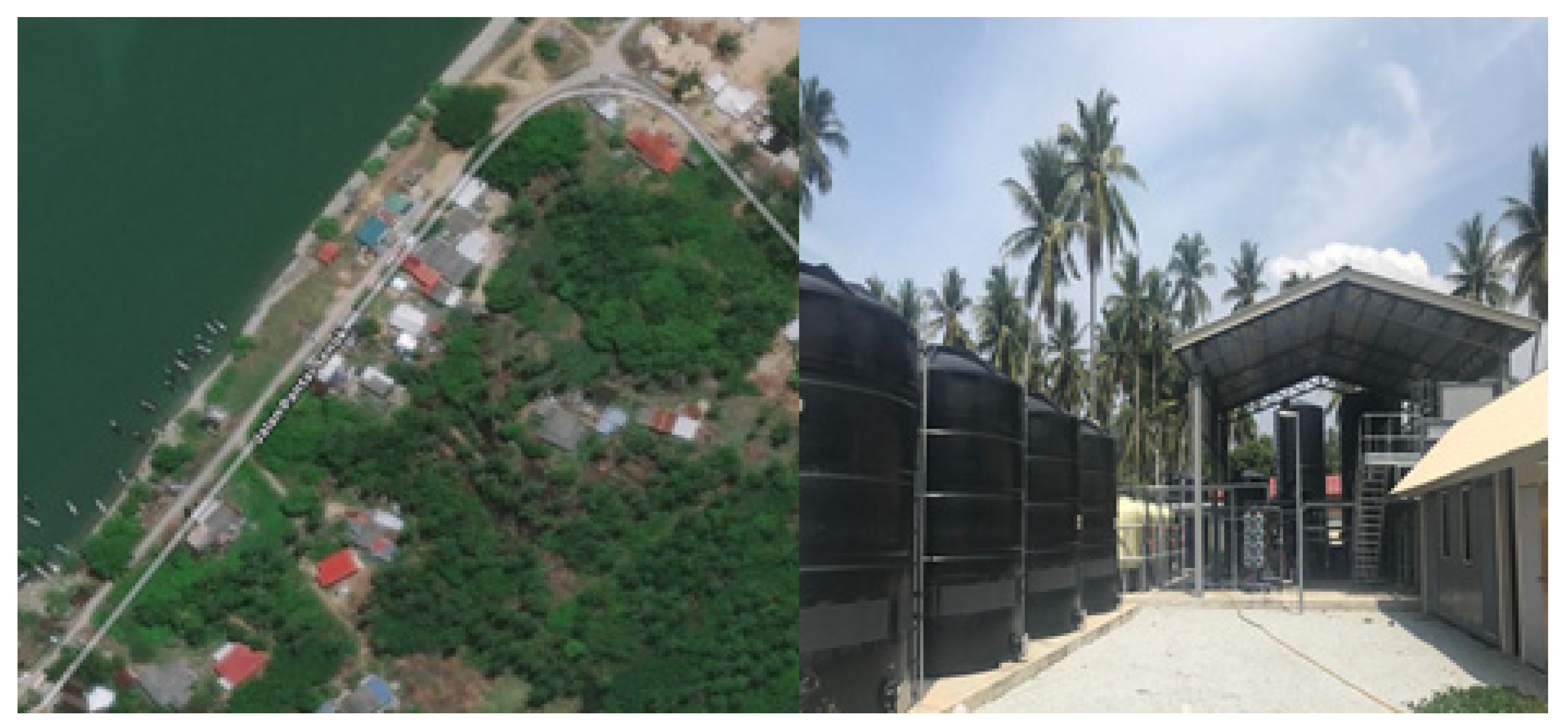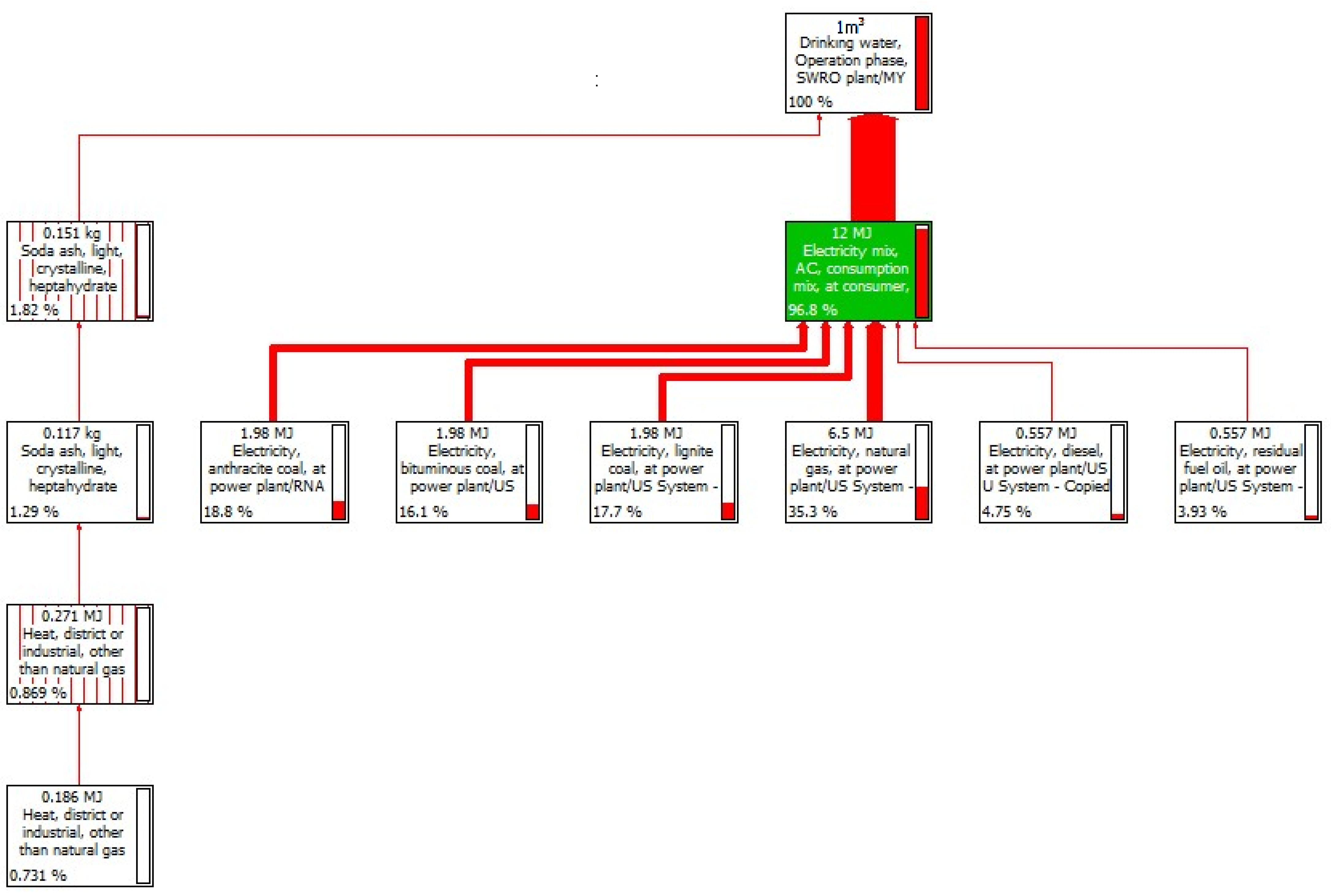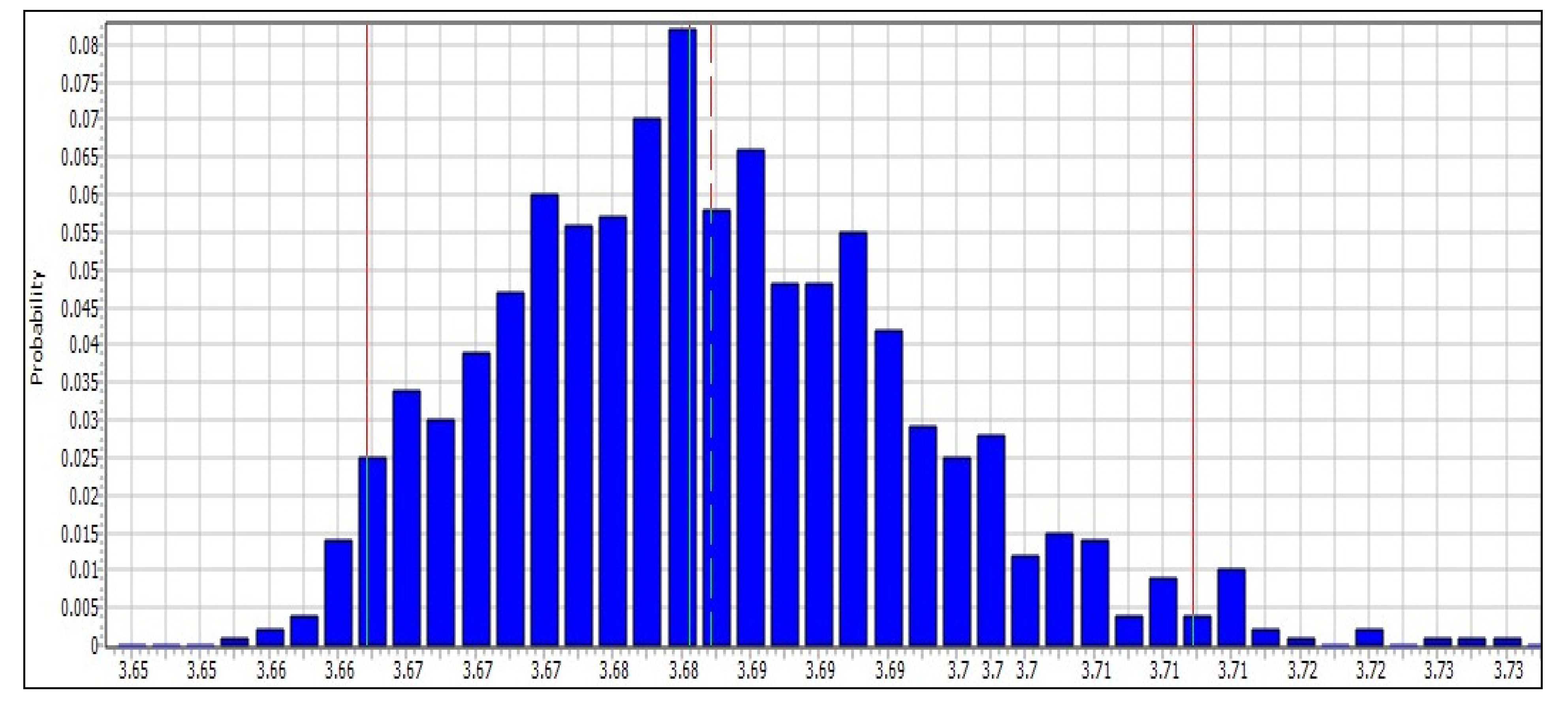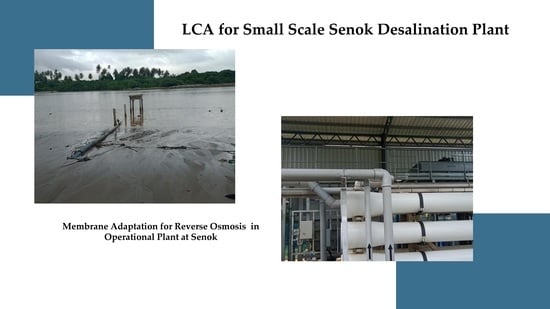Environmental Performance of Small-Scale Seawater Reverse Osmosis Plant for Rural Area Water Supply
Abstract
1. Introduction
2. RO Membranes in Desalination Technologies and Their Novel Theories
3. Materials and Methods
3.1. Area of Study
3.2. The Reverse Osmosis (RO) System
3.3. LCA Method for Seawater Desalination
- (a)
- Phase 1—Goal and Scope Definition: The goal for this research was to study the hotspot of environmental burdens for the SWRO desalination plant in Kampung Pantai Senok. The LCA approach was used as an evaluation method to analyze the environmental effects for both the installation and operational stages of the plant. The system boundary used in this research was gate to gate, which included the type of chemical and the electricity usage during the operational phase of the plant. The functional unit for this research was 1 m3 of desalinated seawater.
- (b)
- Phase 2—Life Cycle Inventory (LCI): This study only involved the operational phase of the seawater desalination process and did not include their piping system, water storage tank, and machinery due to their life time. Referring to Table 1, the LCI analysis contained inputs of chemicals and amount of electricity needed for 1 m3 of desalinated water. The data for chemicals used during the operational stage were obtained from Tarnacki et al. [41]. The energy consumption of seawater desalination plant for the operational phase was considered to be 3.1 kWh.
- (c)
- Phase 3—Life Cycle Impact Assessment (LCIA): The life cycle impact assessment was generated using ReCiPe 2016 from the LCA software, SimaPro 8.5. The input data gathered from the inventory were calculated using the software to evaluate the environmental impacts by the plant processes. The results from LCIA would determine the environmental burdens produced during the operational phase. The results were the midpoint impacts, which included 18 categories. The LCA library contained a database of energy consumption, emission, and material data to produce one unit of product.
- (d)
- Phase 4—Interpretation: The last phase of LCA was the interpretation of the results. This step involved the evaluation of the results from the inventory analysis and environmental impact assessment of the life stage process. The final stage of the desalination process was negligible due to the lower environmental load compared to the construction and operational stages of the desalination system. In conclusion, the outcomes and the recommendations for the product or the process were made for future studies and development.
4. Results and Discussion
4.1. Impact Assessment at the Midpoint Level
4.2. Comparison of the Operational Phase Impacts
4.3. Explantion of Reverse Osmosis (RO)—Water Quality Effects
4.4. Uncertainty Analysis
5. Conclusions
Author Contributions
Funding
Data Availability Statement
Acknowledgments
Conflicts of Interest
References
- Mahmoud, S.; Saffa, B.R. Water desalination technologies utilizing conventional and renewable energy sources. Int. J. Low-Carbon Technol. 2014, 9, 1–19. [Google Scholar]
- Thompson, T.; Fawell, J.; Kunikane, S.; Jackson, D.; Appleyard, S.; Callan, P.; Bartram, J.; Kingston, P. Chemical Safety of Drinking Water: Assessing Priorities for Risk Management; World Health Organization Publisher: Geneva, Switzerland, 2007; pp. 1–100. [Google Scholar]
- Taikan, O.; Quiocho, R.E. Economically challenged and water scarce: Identification of global populations most vulnerable to water crises. Int. J. Water Resour. Dev. 2020, 36, 416–428. [Google Scholar]
- Zhou, J.; Chang, V.W.C.; Fane, A.G. Environmental life cycle assessment of reverse osmosis desalination: The influence of different life cycle impact assessment methods on the characterization results. J. Desalin. 2011, 283, 227–236. [Google Scholar] [CrossRef]
- Farzaneh, M.; Siddiqui, H.; Pishbin, M.; Goordarzi, G.; Dehghani, S.; Date, A.; Akbarzadeh, A. Sustainable seawater desalination by permeate gap membrane distillation technology. J. Energy Procedia 2017, 110, 246–351. [Google Scholar]
- Aziz, N.I.H.A.; Hanafiah, M.M. Application of life cycle assessment for desalination: Progress, challenges and future directions. Environ. Pollut. 2021, 268, 115948. [Google Scholar] [CrossRef]
- Burn, S.; Hoang, M.; Zarzo, D.; Olewniak, F.; Campos, E.; Bolto, B.; Barron, O. Desalination techniques-A review of the opportunities for desalination in agriculture. Desalination 2015, 364, 2–16. [Google Scholar] [CrossRef]
- Abdel-Aal, E.; Farid, M.; Mohamed, A.; Mohamed, A.E. Desalination of red sea water using both electrodialysis and reverse osmosis as complementary methods. Egypt. J. Pet. 2015, 24, 71–75. [Google Scholar] [CrossRef]
- Zuraini, A.; Jaharudin, P.; Noorhaslinda Kulub, A.R.; Roseliza, M.A.; Haslina, M. Factors Affecting Water Demand: Macro Evidence in Malaysia. J. Ekon. Malays. 2019, 53, 17–25. [Google Scholar]
- Abdul Rahman, H. Water shortage in Malaysia: Again? Malays. Consum. Law J. 2014, 1, 115–128. [Google Scholar]
- National Water Resources. Review the National Water Resources (2000–2050) and Formulation of National Water Resources Policy-Volume 6 Water Resources Decision Support System Framework, Final Report. Malaysia. Available online: https://www.water.gov.my/jps (accessed on 10 June 2010).
- Zhou, J.; Chang, V.W.C.; Fane, A.G. Life cycle assessment for desalination: A review on methodology feasibility and reliability. J. Water Res. 2014, 61, 210–223. [Google Scholar] [CrossRef]
- Daniella, S.; Stephanie, K.L.; Ishii, P.W.E. Case study of life cycle assessment of coastal utility experiencing saltwater intrusion. J. AWWA 2015, 107, 543–548. [Google Scholar]
- Pieragostini, C.; Mussati, M.C.; Aguirre, P. On process optimization considering LCA methodology. J. Environ. Manag. 2012, 96, 43–54. [Google Scholar] [CrossRef] [PubMed]
- Jia, X.; Klemeš, J.J.; Petar, S.V.; Sharifah Rafidah, W.A. Analyzing the Energy Consumption, GHG Emission, and Cost of Seawater Desalination in China. Energies 2019, 12, 463. [Google Scholar] [CrossRef]
- ISO 14040. Environmental Management: Life Cycle Assessment–Principle of Framework; CEN: Brussels, Belgium, 2006; pp. 1–35. [Google Scholar]
- Obotey Ezugbe, E.; Rathilal, S. Membrane Technologies in Wastewater Treatment: A Review. Membranes 2020, 10, 89. [Google Scholar] [CrossRef]
- Homaeigohar, S.; Elbahri, M. Graphene membranes for water desalination. NPG Asia Mater. 2017, 9, e427. [Google Scholar] [CrossRef]
- Tian, X.; Cao, Z.; Wang, J.; Chen, J.; Wei, Y. Development of high-performance mixed matrix reverse osmosis membranes by incorporating aminosilane-modified hydrotalcite. RSC Adv. J. 2020, 10, 5648–5655. [Google Scholar] [CrossRef]
- Zhang, Z.; Zhang, F.; Liu, Z.; Cheng, G.; Wang, X.; Ding, J. Molecular Dynamics Study on the Reverse Osmosis Using Multilayer Porous Graphene Membranes. Nanomaterials 2018, 8, 805. [Google Scholar] [CrossRef]
- Zhang, Z.; Li, S.; Mi, B.; Wang, J.; Ding, J. Surface slip on rotating graphene membrane enables the temporal selectivity that breaks the permeability-selectivity trade-off. Sci. Adv. 2020, 6, eaba9471. [Google Scholar] [CrossRef]
- Zamri, W.M. Groundwater for domestic needs in Kelantan. Water Malays. 2009, 20, 6–10. [Google Scholar]
- Lawler, W.; Alvarez-Gaitan, J.; Leslie, G.; Le-Clech, P. Comparative life cycle assessment of end-of-life options for reverse osmosis membranes. J. Desalin. 2015, 444, 44–52. [Google Scholar] [CrossRef]
- Atab, S.M.; Smallbone, A.J.; Roskilly, A.P. A Hybrid reverse osmosis/adsorption desalination plant for irrigation and drinking water. J. Desalin. 2018, 444, 44–52. [Google Scholar] [CrossRef]
- Mulder, M. Basic Principle of Membrane Technology, 2nd ed.; Kluwer Academic Publishers: Boston, MA, USA, 1996; pp. 1–20. [Google Scholar]
- McGregor, W.C. Membrane Separation in Biotechnology; Taylor & Francis Group: New York, NY, USA, 1986; pp. 1–30. [Google Scholar]
- Alzahrani, S.; Mohammad, A.W. Challenges and trends in membrane technology implementation for produced water treatment: A review. J. Water Process Eng. 2014, 4, 107–133. [Google Scholar] [CrossRef]
- Glater, J. The early history of reverse osmosis membrane development. Desalination 1998, 117, 297–309. [Google Scholar] [CrossRef]
- Uemura, T.; Kotera, K.; Henmi, M.; Tomioka, H. Membrane technology in seawater desalination: History, recent developments and future prospects. Desalin. Water Treat. 2011, 33, 283–288. [Google Scholar] [CrossRef]
- Yang, Z.; Zhou, Y.; Feng, Z.; Rui, X.; Zhang, T.; Zhang, Z. A Review on Reverse Osmosis and Nanofiltration Membranes for Water Purification. Polymers 2019, 11, 1252. [Google Scholar] [CrossRef]
- Rodríguez-Calvo, A.; Silva-Castro, G.A.; Osorio, F.; González-López, J.; Calvo, C. Reverse osmosis seawater desalination: Current status of membrane systems. Desalin. Water Treat. 2015, 56, 849–861. [Google Scholar] [CrossRef]
- Li, D.; Wang, H. Recent developments in reverse osmosis desalination membranes. J. Mater. Chem. 2010, 22, 4551–4566. [Google Scholar] [CrossRef]
- Ghernaout, D. Reverse Osmosis Process Membranes Modeling—A Historical Overview. J. Civ. Constr. Environ. Eng. 2017, 4, 112–122. [Google Scholar]
- Rautenbach, R.; Albrecht, R. Membrane Processes; John Wiley & Sons: New York, NY, USA, 1989; pp. 1–35. [Google Scholar]
- Al-Nory, M.; Graves, S. Water desalination supply chain modeling and optimization, Date Engineering Workshops (ICDEW). In Proceedings of the 2013 IEEE 29th International Conference, Brisbane, Australia, 8–11 April 2013. [Google Scholar]
- Almansoori, A.; Saif’, Y. Design and operation of water desalination supply chain using mathematical modelling approach. Desalination 2014, 351, 184–201. [Google Scholar]
- Martins, A.A.; Caetano, N.S.; Mata, T.M. LCA for Membrane Processes. In Sustainable Membrane Technology for Water and Wastewater Treatment; Springer: Singapore, 2017; pp. 23–63. [Google Scholar]
- Raluy, R.G.; Serra, L.; Uche, J. Life Cycle Assessment of water production technologies. Part 1: Life Cycle Assessment of different commercial desalination technologies (MSF, MED, RO). Int. J. Life Cycle Assess. 2005, 10, 285–293. [Google Scholar] [CrossRef]
- Abdul Ghani, L.; Nazaran, I.S.; Ali, N.; Hanafiah, M.M. Improving Prediction Accuracy of Socio-Human Relationships in a Small-Scale Desalination Plant. Sustainability 2020, 12, 6949. [Google Scholar] [CrossRef]
- Ehsan Yakavalangi, M.; Rimaz, S.; Vatanpour, V. Effect of surface properties of polysulfone support on the performance of thin film composite polyamide reverse osmosis membranes. J. Appl. Polym. 2017, 134. [Google Scholar] [CrossRef]
- Tarnacki, K.; Menese, M.; Melin, T.; Medevoort, J.V.; Jansen, A. Environmental assessment of desalination processes: Reverse osmosis and memstill. J. Desalin. 2012, 296, 69–80. [Google Scholar] [CrossRef]
- De Schryver, A.; Struijs, J.; Van Zelm, R. Recipe 2008: A Life Cycle Impact Assessment Method Which Comprises Harmonised Category Indicators at the Midpoint and the Endpoint Level; Ministry of Housing, Spatial Planning and the Environment: Amersfoort, The Netherlands, 2009; pp. 1–50.
- Huijbregts, M.A.J.; Steinmann, Z.J.N.; Elshout, P.M.F.; Stam, G.; Verones, F.; Vieira, M.D.M.; Van Zelm, R. ReCiPe 2016 v1.1. A Harmonized Life Cycle Impact Assessment Method at Midpoint and Endpoint Level. Report I: Characterization; Department of Environmental Science, Radbound University: Nijmegen, The Netherlands, 2017; pp. 1–40. [Google Scholar]
- Hancock, N.T.; Black, N.D.; Cath, T.Y. A comparative life cycle assessment of hybrid osmotic dilution desalination and wastewater reclamation processes. J. Water Res. 2012, 46, 1145–1154. [Google Scholar] [CrossRef] [PubMed]
- Monnot, M.; Nguyen, H.T.K.; Laborie, S.; Cabassud, C. Seawater reverse osmosis desalination plant at community-scale: Role of an innovative pre-treatment on process performances and intensification. J. Chem. Eng. Process. Process Intensif. 2017, 113, 42–55. [Google Scholar] [CrossRef]
- Mannan, M.; Alhaj, M.; Mabrouk, A.N.; Al-Ghamdi, S.G. Examining the life-cycle environmental impacts of desalination: A case study in the State of Qatar. Desalination 2019, 452, 238–246. [Google Scholar] [CrossRef]
- Zolfagharian, S.; Nourbakhsh, M.; Izizarry, J.; Raessang, A.; Gheisari, M. Environmental impact assessment on construction sites. Constr. Res. Congr. 2012, 1, 1750–1757. [Google Scholar]
- Mannan, M.; Al-Ghamdi, S.G. Integrating concentrated solar power with seawater desalination technologies: A multiregional environmental assessment. Environ. Res. Lett. 2019, 14, 074014. [Google Scholar]
- Goga, T.; Friedrich, E.; Buckley, C.A. Environmental life cycle assessment for potable water production—A case study of se water desalination and mine-water reclamation in South Africa. Water SA 2019, 45, 700–709. [Google Scholar] [CrossRef]
- Sabine, L.; Thomas, H. Environmental impact and impact assessment of seawater desalination. Desalination 2008, 220, 1–15. [Google Scholar]
- Wolska, J.; Bryjak, M. Methods for boron removal from aqueous solutions—A review. J. Desalin. 2013, 310, 18–24. [Google Scholar] [CrossRef]
- Alkhudhiri, A.; Bin Darwish, N.; Hakami, M.W.; Abdullah, A.; Alsadun, A.; Abu Homod, H. Boron Removal by Membrane Distillation: A Comparison Study. Membranes 2020, 10, 263. [Google Scholar] [CrossRef] [PubMed]
- Finnveden, G. On the Limitations of Life Cycle Assessment and Environmental Systems Analysis Tools in General. Int. J. Life Cycle Assess. 2012, 5, 229–238. [Google Scholar] [CrossRef]





| Input | Unit | Amount |
|---|---|---|
| Input from Nature: | ||
| Seawater | m3 | 1 |
| Inputs from Technosphere: | ||
| Electricity | kWh | 3.1 |
| Chlorine | kg | 0.001 |
| Hydrochloric acid | kg | 0.05 |
| Polyacrymide | kg | 0.0024 |
| Polyaluminium chloride | kg | 0.0036 |
| Soda ash | kg | 0.36 |
| Sodium hydrogen sulfite | kg | 0.012 |
| Sodium hydroxide | kg | 0.006 |
| Sodium phosphate | kg | 0.006 |
| Impact Category | Total | Unit |
|---|---|---|
| Climate change | 2.6 × 10−0 | kg CO2 eq |
| Ozone depletion | 1.0 × 10−8 | kg CFC−11 eq |
| Terrestrial acidification | 3.2 × 10−2 | kg SO2 eq |
| Freshwater eutrophication | 1.2 × 10−5 | kg P eq |
| Marine eutrophication | 2.7 × 10−4 | kg N eq |
| Human toxicity | 4.1 × 10−1 | kg 1,4-DB eq |
| Photochemical oxidant formation | 7.7 × 10−3 | kg NMVOC |
| Particulate matter formation | 7.1 × 10−3 | kg PM10 eq |
| Terrestrial ecotoxicity | 4.1 × 10−5 | kg 1,4-DB eq |
| Freshwater ecotoxicity | 4.0 × 10−3 | kg 1,4-DB eq |
| Marine ecotoxicity | 4.1 × 10−3 | kg 1,4-DB eq |
| Ionizing radiation | 5.9 × 10−3 | kBq U235 eq |
| Agricultural land occupation | 1.4 × 10−3 | m2a |
| Urban land occupation | 3.3 × 10−4 | m2a |
| Natural land transformation | 6.3 × 10−6 | m2 |
| Water depletion | 8.6 × 10−4 | m3 |
| Metal depletion | 2.8 × 10−3 | kg Fe eq |
| Fossil depletion | 9.1 × 10−1 | kg oil eq |
| Aspects | Desalination Process | Recommendations/Comments |
|---|---|---|
| Energy use | The use of 2 kWh per m3 of energy from the Tenaga Nasional Berhad (TNB) grid has the second largest ecological impact especially on the terrestrial ecotoxicity and photochemical oxidation. |
|
| Water use | For 1 m3 of water product, the SWRO plant treats 3 m3 of feed water with antiscalant (i.e., the entire flow). |
|
| Material usage | The impact triggered by the seawater inhalation process using a pump motor on a long pipeline at the Senok SWRO plant shows the value of the most important damage effects on abiotic and eutrophic aquatic ecosystems, ozone depletion, and photochemical oxidation. |
|
| Disposal of the concentrate | The concentrated discharge of salt water has the greatest potential for environmental impact in the study area. This is due to the amount of pollutants present in salt solutions containing chemical concentrations and salinity, dissolved oxygen in water, quantity of organic matter, acids, pH, temperature, and effluent, which must be monitored together. The three environmental effects that are considered important in this study area are toxicity to humans and aquatic species, resource extraction, and acidification. |
|
| Chemicals | The impact of each chemical used in the operational stage, including the post-treatment and installation stage can be assessed. According to the results of the normalization for the post-treatment stage, sulfuric acid has the highest environmental impact. Moreover, the results are different for the pre-treatment process. The iron chloride used as a coagulant also has the highest impact on the ozone layer depletion and terrestrial ecotoxicity. Meanwhile, the use of lime for the purpose of remineralization has important criteria in the release of greenhouse gases, leading to a reduction in the ozone layer and an increase in ultraviolet radiation into the air. Finally, the sulfuric acid used for pH monitoring and water quality data recorded elevated chemical contributions, leading to the category of destruction of respiratory damage to humans and land acidification effects. |
|
| Parameter | Unit | Senok Seawater | Senok SWRO | Permitted Level * |
|---|---|---|---|---|
| Physical Standard | ||||
| pH | - | 7.6 | 6.5 | 6.5–8.5 |
| Colour | TCU | 10 | <5 | 15 |
| Turbidity | NTU | 2.7 | 0.3 | 2 |
| Chemical Standard | ||||
| Aluminum (Al) | mg/L | 0.05 | ND (<0.02) | 0.2 |
| Barium (Ba) | mg/L | 0.08 | ND (<0.02) | 0.7 |
| Biocides (Total) | mg/L | ND | ND | 0.1 |
| Boron (B) | mg/L | 2.7 | 0.5 | 0.5 |
| Cadmium (Cd) | mg/L | ND (<0.002) | ND (<0.002) | 0.003 |
| Carbon Chloroform Extract | mg/L | ND | ND | 0.5 |
| Chloride | mg/L | 14,120 | 110 | 250 |
| Floride (F) | mg/L | <0.1 | <0.1 | 0.6 |
| Hardness (CaCO3) | mg/L | 4300 | 4 | 500 |
| Iron (Fe) | mg/L | 0.19 | ND (<0.02) | 0.3 |
| Lead (Pb) | mg/L | ND (<0.01) | ND (<0.01) | 0.01 |
| Magnesium (Mg) | mg/L | 871 | 0.8 | 150 |
| Manganese (Mn) | mg/L | 0.05 | ND (<0.02) | 0.1 |
| Mercury (Hg) | mg/L | ND (<0.001) | ND (<0.001) | 0.001 |
| Mineral Oil | mg/L | ND | ND | 0.3 |
| Nickel (Ni) | mg/L | ND (<0.02) | ND (<0.02) | 0.02 |
| Nitrite (NO2−) | mg/L | <0.1 | <0.1 | 50 |
| Nitrate (NO3−) | mg/L | <0.1 | 0.1 | 10 |
| Nitrate (N) | mg/L | <0.1 | <0.1 | 0.002 |
| Phenol (CH4H2OH) | ND (<0.002) | ND (<0.002) | 0.002 | |
| Residual Chlorine (CI2) | mg/L | 0.13 | 0.05 | ≥0.2 |
| Sodium (Na) | mg/L | 3793 | 54 | 200 |
| Styrene | mg/L | ND | ND | 0.2 |
| Sulfate | mg/L | 180 | 4 | 250 |
| Zinc (Zn) | mg/L | 0.06 | 0.15 | 3 |
| Total Dissolved Solids | mg/L | 17,100 | 150 | - |
Publisher’s Note: MDPI stays neutral with regard to jurisdictional claims in published maps and institutional affiliations. |
© 2021 by the authors. Licensee MDPI, Basel, Switzerland. This article is an open access article distributed under the terms and conditions of the Creative Commons Attribution (CC BY) license (http://creativecommons.org/licenses/by/4.0/).
Share and Cite
Abdul Ghani, L.; Ali, N.; Nazaran, I.S.; Hanafiah, M.M. Environmental Performance of Small-Scale Seawater Reverse Osmosis Plant for Rural Area Water Supply. Membranes 2021, 11, 40. https://doi.org/10.3390/membranes11010040
Abdul Ghani L, Ali N, Nazaran IS, Hanafiah MM. Environmental Performance of Small-Scale Seawater Reverse Osmosis Plant for Rural Area Water Supply. Membranes. 2021; 11(1):40. https://doi.org/10.3390/membranes11010040
Chicago/Turabian StyleAbdul Ghani, Latifah, Nora’aini Ali, Ilyanni Syazira Nazaran, and Marlia M. Hanafiah. 2021. "Environmental Performance of Small-Scale Seawater Reverse Osmosis Plant for Rural Area Water Supply" Membranes 11, no. 1: 40. https://doi.org/10.3390/membranes11010040
APA StyleAbdul Ghani, L., Ali, N., Nazaran, I. S., & Hanafiah, M. M. (2021). Environmental Performance of Small-Scale Seawater Reverse Osmosis Plant for Rural Area Water Supply. Membranes, 11(1), 40. https://doi.org/10.3390/membranes11010040







